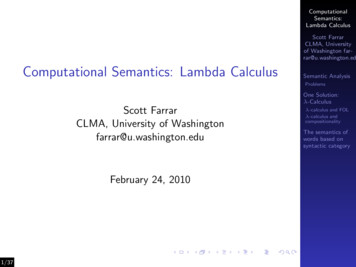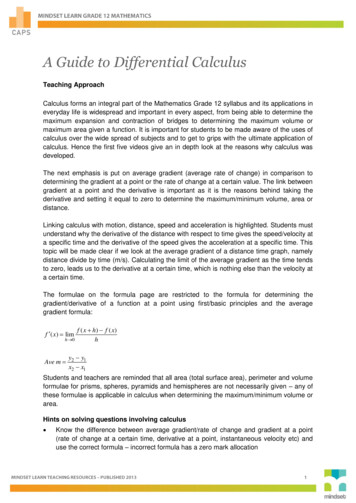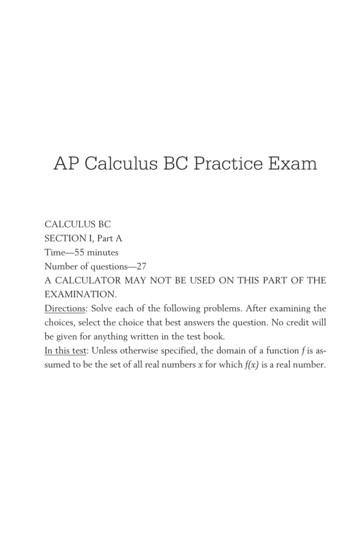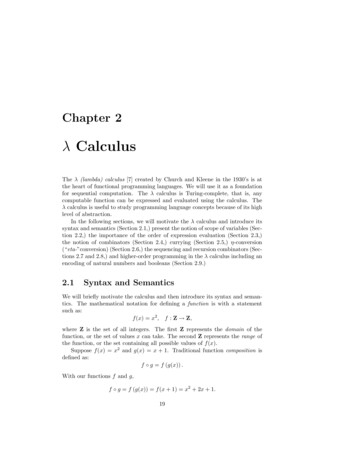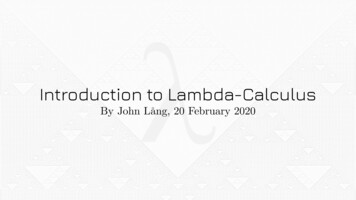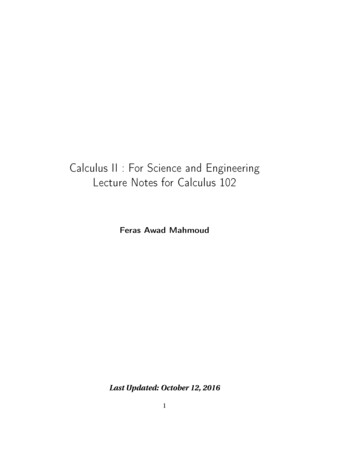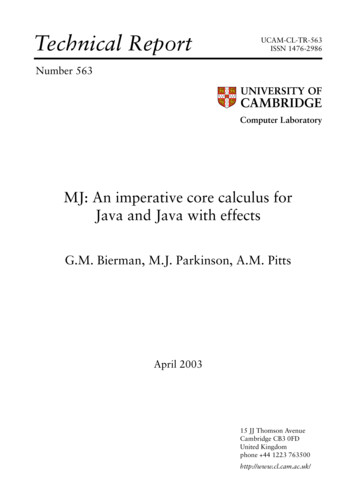
Transcription
Technical ReportUCAM-CL-TR-563ISSN 1476-2986Number 563Computer LaboratoryMJ: An imperative core calculus forJava and Java with effectsG.M. Bierman, M.J. Parkinson, A.M. PittsApril 200315 JJ Thomson AvenueCambridge CB3 0FDUnited Kingdomphone 44 1223 763500http://www.cl.cam.ac.uk/
c 2003 G.M. Bierman, M.J. Parkinson, A.M. PittsTechnical reports published by the University of CambridgeComputer Laboratory are freely available via the s editor: Markus KuhnISSN 1476-2986
MJ: An imperative core calculus for Java and Java with effectsG.M. Bierman M.J. Parkinson A.M. PittsUniversity of Cambridge Computer Laboratory,J.J. Thomson Avenue, Cambridge. CB3 0FD. UK.{gmb,mjp41,amp12}@cl.cam.ac.ukAbstractIn order to study rigorously object-oriented languages such as Java or C] , a common practice is to define lightweight fragments, or calculi, which are sufficiently smallto facilitate formal proofs of key properties. However many of the current proposals forcalculi lack important language features. In this paper we propose Middleweight Java,MJ, as a contender for a minimal imperative core calculus for Java. Whilst compact,MJ models features such as object identity, field assignment, constructor methods andblock structure. We define the syntax, type system and operational semantics of MJ,and give a proof of type safety. In order to demonstrate the usefulness of MJ to reasonabout operational features, we consider a recent proposal of Greenhouse and Boyland toextend Java with an effects system. This effects system is intended to delimit the scope ofcomputational effects within a Java program. We define an extension of MJ with a similareffects system and instrument the operational semantics. We then prove the correctnessof the effects system; a question left open by Greenhouse and Boyland. We also considerthe question of effect inference for our extended calculus, detail an algorithm for inferringeffects information and give a proof of correctness.1IntroductionIn order to understand the design of programming languages, and to develop better verificationmethods for programmers and compiler writers, a common practice is to develop a formalmodel. This formal model, or calculus, often takes the form of a small, yet interesting fragmentof the programming language in question. Recently there has been a number of proposals fora core calculus for the Java programming language. Most notable is Featherweight Java [12],or FJ, which is a core calculus intended to facilitate the study of various aspects of the Javatype system, including a proposal for extending Java with generic classes.In contrast to the main motivation for FJ, we are as much interested in various operationalproperties of Java, as in its type system. To this extent, FJ is an oversimplification as it issimply a functional fragment of Java; many of the difficulties with reasoning about Java codearise from its various imperative features. Thus in this paper we propose Middleweight Java,or MJ, as a contender for a minimal imperative core calculus for Java. MJ can be seen asan extension of FJ big enough to include the essential imperative features of Java; yet smallenough that formal proofs are still feasible. In addition to FJ, we model object identity, fieldassignment, null pointers, constructor methods and block structure.MJ is intended to be a starting point for the study of various operational features of objectoriented programming in Java. To demonstrate this utility we consider extending the MJ type3
system with effects. An effects system can be used to delimit the scope of computational effectswithin a program. Effects systems originated in work by Gifford and Lucassen [8, 16], andwere pursued by Talpin and Jouvelot [19, 20], amongst others. Interestingly most of thesesystems were defined for functional languages with simple forms of state. 1 Greenhouse andBoyland [10] have recently suggested how an effects system could be incorporated within Java.The key difficulty is the interaction between the effects system and the abstraction facilities(mainly the notions of class and subclass) that makes Java, and object-oriented programmingin general, attractive.Although Greenhouse and Boyland give a precise description of their effects system anda number of examples, they do not give a proof of correctness. Having formally defined ourMJ effects system and instrumented operational semantics we are able to prove it correct. Inaddition, Greenhouse and Boyland leave the question of effect inference to “further work”.Again we formally define an algorithm to infer effect annotations and prove it correct. Thusour work in this paper can be seen as both an extension and a formal verification of theirproposal: our theory underpins their computational intuitions.This paper is organised as follows. In §2 we give the syntax, type system and operational semantics of MJ. In §2.5 we outline a proof of type soundness; the details are given inAppendix 5. In §3 we define MJe, which is an extension of MJ with effects in the style ofGreenhouse and Boyland. In §3.3 we outline a proof of correctness for the effects system ofMJe; again the details are given in Appendix 5. In §3.4 we consider the problem of effectsinference, define an inference algorithm and prove it correct. We survey some related workin §4, and give conclusions and indications of further work in §5.2MJ: An imperative core Java calculusIn this section we define Middleweight Java, MJ, our proposal for an imperative core calculusfor Java. It is important to note that MJ is an entirely valid subset of Java, in that all MJprograms are literally executable Java programs. Clearly this is a attractive feature of the MJdesign, although we found in a number of places that it complicated matters. An alternativewould be to allow extra-language features; for example, Classic Java uses annotations and letbindings which are not valid Java syntax in the operational semantics [7].In the rest of this section we present the syntax, type system and single-step operationalsemantics for MJ. We conclude the section with a proof of correctness of the type system.2.1SyntaxThe syntax, for MJ programs, is given in Figure 1. An MJ program is thus a collection ofclass definitions plus a sequence of statements, s, to be evaluated. This sequence correspondsto the body of the main method in a Java program [9, §12.1.4].For example, here are some typical MJ class definitions.1Another approach for lazy functional programming with state is the use of monads [21]. Wadler has shownthat effects systems can easily be adapted to monads [22].4
Programp :: cd 1 . . . cd n ; sClass definitioncd :: class C extends C{fd 1 . . . fd kcndmd 1 . . . md n }Field definitionfd :: C f ;Constructor definitioncnd :: C(C1 x1 , . . . , Cj xj ){super(e1 , . . . , ek ); s1 . . . sn }Method definitionmd :: τ m(C1 x1 , . . . , Cn xn ){s1 . . . sk }Return typeτ :: C voidExpressione :: x null e.f (C)e pePromotable expressionpe :: e.m(e1 , . . . , ek ) new C(e1 , . . . , ek )Statements :: ; pe; if (e e){s1 . . . sk } else {sk 1 . . . sn } e.f e; C x; x e; return e; {s1 . . . sn }VariableNullField accessCastPromotable expressionMethod invocationObject creationNo-opPromoted expressionConditionalField assignmentLocal variable declarationVariable assignmentReturnBlockFigure 1: Syntax for MJ programsclass Cell extends Object{Object contents;Cell (Object start){super();this.contents start;};void set(Object update){this.contents update;};}class Recell extends Cell{Object undo;Recell (Object start){super(start);this.undo null;};void set(Object update){this.undo this.contents;this.contents update;};}This code defines two classes: Cell which is a subclass of the Object class, and Recellwhich is a subclass of Cell. The Cell class has one field, contents. The constructor methodsimply assigns the field to the value of the parameter. The Cell class defines a method set,which sets the field to a given value.Recell objects inherit the contents field from their superclass, and also have another5
field, undo. The constructor method first calls the superclass constructor method (which willassign the contents field) and then sets the undo field to the null object. The Recell classdefinition overrides the set method of its superclass.As with Featherweight Java, we will insist on a certain amount of syntactic regularity inclass definitions, although this is really just to make the definitions compact. We insist thatall class definitions (1) include a supertype (we assume a distinguished class Object); (2)include a constructor method (currently we only allow a single constructor method per class);(3) have a call to super as the first statement in a constructor method; (4) have a return atthe end of every method definition except for void methods (this constraint is enforced bythe type system); and (5) write out field accesses explicitly, even when the receiver is this.In what follows, again for compactness, we assume that MJ programs are well-formed,i.e. we insist that (1) they do not have duplicate definitions for classes, fields and methods(currently we do not allow overloaded methods for simplicity—as overloading is determinedstatically, overloaded methods can be simulated faithfully in MJ); (2) fields are not redefined insubclasses (we do not allow shadowing of fields); and (3) there are no cyclic class definitions(for example A extends B and B extends A). We do not formalise these straightforwardconditions.A class definition contains a collection of field and method definitions, and a single constructor definition. A field is defined by a type and a name. Methods are defined as a returntype, a method name, an ordered list of arguments, where an argument is a variable nameand type, and a body. A constructor is defined by the class name, an ordered list of arguments and a body. There are a number of well-formedness conditions for a collection of classdefinitions which are formalised in the next section.The rest of the definition, in Figure 1, defines MJ expressions and statements. We assumea number of metavariables: f ranges over field names, m over method names, and x overvariables. We assume that the set of variables includes a distinguished variable, this, whichis not permitted to occur as the name of an argument to a method or on the left of anassignment. In what follows, we shall find it convenient to write e to denote the possiblyempty sequence e0 , . . . , en (and similarly for C, x, etc.). We write s to denote the sequences1 . . . sn with no commas (and similarly for fd and md ). We abbreviate operations on pairs ofsequences in the obvious way, thus for example we write C x for the sequence C1 x1 , . . . , Cn xnwhere n is the length of C and x.The reader will note MJ has two classes of expressions: the class of ‘promotable expressions’, pe, defines expressions that can be can be promoted to statements by postfixing asemicolon ‘;’; the other, e, defines the other expression forms. This slightly awkward divisionis imposed upon us by our desire to make MJ a valid fragment of Java. Java [9, §14.8] onlyallows particular expression forms to be promoted to statements by postfixing a semicolon.This leads to some rather strange syntactic surprises: for example, x ; is a valid statement,but (x ); is not!MJ includes the essential imperative features of Java. Thus we have fields, which canbe both accessed and assigned to, as well as variables, which can be locally declared andassigned to. As with Java, MJ supports block-structure; consider the following valid MJ codefragment.if(var1 var2) { ; }else {Object temp;6
temp var1;var1 var2;var2 temp;}This code compares two variables, var1 and var2. If they are not equal then it creates anew locally scoped variable, temp, and uses this to swap the values of the two variables. Atthe end of the block, temp will no longer be in scope and will be removed from the variablestack.2.2TypesAs with FJ, for simplicity, MJ does not have primitive types, sometimes called base types.Thus all well-typed expressions are of a class type, C. All well-typed statements are of typevoid, except for the statement form return e; which has the type of e (i.e. a class type). Weuse τ to range over valid statement types. The type of a method is a pair, written C τ ,where C is a sequence of argument types and τ is the return type (if a method does not returnanything, its return type is void). We use µ to range over method types.Expression typesCa valid class name, including a distinguished class ObjectStatement typesτ :: void CMethod typesµ :: C1 , . . . , Cn τJava, and MJ, class definitions contain both typing information and code. This typinginformation is extracted and used to typecheck the code. Thus before presenting the typechecking rules we need to specify how this typing information is induced by MJ code.This typing information consists of two parts: The subclassing relation, and a class table(which stores the types associated with classes). First let us consider the subclassing relation.Recall that in MJ we restrict class declarations so that they must give the name of class thatthey are extending, even if this class is the Object class.A well-formed program, p, then induces an immediate subclassing relation, which wewrite 1 . We define the subclassing relation, , as the reflexive, transitive closure of thisimmediate subclassing relation. This can be defined formally as follows.[TR-Immediate]class C1 extends C2 {. . .} pC1 1 C2[TR-Extends]C1 1 C2C1 C 2[TR-Transitive]C1 C 2C2 C 3C1 C 3[TR-Reflexive]C CA well-formed program p also induces a class table, p . As the program is fixed, we willsimply write this as . A class table, , is actually a triple, ( m , c , f ), which providestyping information about the methods, constructors, and fields, respectively. m is a partialmap from a class name to a partial map from a method name to that method’s type. Thus7
m (C)(m) is intended to denote the type of method m in class C. c is a partial map froma class name to the type of that class’s constructor method. f is a partial map from a classname to a map from a field name to a type. Thus f (C)(f ) is intended to denote the typeof f in class C. The details of how a well-formed program p induces a class table are givenbelow.Method Typedef m (C)(m) (C C 000 m (C )(m)where md i C 00 m(C x){. . .}, for some i, 1 i nwhere m / md 1 . . . md nwhere class C extends C 0 {fd cnd md 1 . . . md n } pConstructor Typedef c (C) C1 , . . . , Cjwhere class C extends C 0 {fd cnd md } pand cnd C(C1 x1 , . . . , Cj xj ){. . .}Field Typedef f (C)(f ) (C 00 f (C 0 )(f )where fd i C 00 f, for some i, 1 i k and f (C 0 )(f ) otherwisewhere class C extends C 0 {fd 1 . . . fd k cnd md } pUp to now we have assumed that the class definitions are well-formed. Now let us defineformally well-formedness of class definitions. First we will find it useful to define when a type(either a method type or statement type) is well-formed with respect to a class table. This iswritten as a judgement µ ok which means that µ is a valid type given the class table .We overload this judgement form for statement types. (We define dom( ) to be the domainof f , m or c , which are all equal.)[T-CType][T-VType][T-MType] C okwhere C dom( ) void ok C1 ok. Cn ok τ ok C1 , . . . , Cn τ okNow we define formally the judgement for well-formed class tables, which is written ok.This essentially checks two things: firstly that all types are valid given the classes defined inthe class table, and secondly that if a method is overridden then it is so at the same type.The judgements are as follows.8
[T-FieldsOk] f (C)(f1 ) ok. f (C)(fn ) ok f (C) ok[T-ConsOK] C1 ok. Cn ok c (C) okwhere dom( f (C)) {f1 , . . . , fn }where c (C) C1 , . . . , Cnwhere m (C)(m) µC 1 C 0 m (C 0 )(m) µ0µ µ0where m (C)(m) µC 1 C 0m 6 dom( m (C 0 )) µ ok[T-MethOk1] C.m ok[T-MethOk2][T-MethsOk][T-ClassOK] µ ok C.m ok C.m1 ok . . . C.mn ok m (C) ok f (C) ok m (C) ok ok c (C) okwhere dom( m (C)) {m1 , . . . , mn } C dom( )We can now define the typing rules for expressions and promotable expressions. Ourtreatment of casting is the same as in FJ—thus we include a case for ‘stupid’ casting, wherethe target class is completely unrelated to the subject class. This is needed to handle thecase where an expression without stupid casts may reduce to one containing a stupid cast.Consider the following expression, taken from [12], where classes A and B are both defined tobe subclasses of the Object class, but are otherwise unrelated.(A)(Object)new B()According to the Java Language Specification [9, §15.16], this is well-typed, but considerits operational behaviour: a B object is created and is dynamically upcast to Object (whichhas no dynamic effect). At this point we wish to downcast the B object to A—a ‘stupid’ cast!Thus if we wish to maintain a subject reduction theorem (that the result of a single stepreduction of a well-typed program is also a well-typed program) we need to include the [TEStupidCast] rule. For the same reason, we also require two rules for typing an if statement.Java [9, §15.21.2] enforces statically that when comparing objects, one object should be asubclass of the other. However this is not preserved by the dynamics. Consider again theunrelated classes A and B. The following code fragment is well-typed but at runtime will endup comparing objects of unrelated classes.if ((Object)new A() (Object)new D()) { . } else {.};The reader should note that a valid Java/MJ program is one that does not have occurrences of [TE-StupidCast] or [TS-StupidIf] in its typing derivation.A typing environment, Γ, is a map from program variables to expression types. We writeΓ, x : C to denote the map Γ extended so that x maps to C. We write Γ ok to mean9
that the types in the codomain of the typing environment are well-formed with respect to theclass table, .A typing judgement for a given MJ expression, e, is written ; Γ e : C where is a classtable and Γ is a typing environment. These rules are given below and are fairly intuitive exceptperhaps [TE-Null], which allows the null value to have any valid type (see [9, §4.1]). Oneinteresting fact about the evaluation of null is (C)(Object)(B)e will only reduce, withoutgenerating an exception, if e evaluates to null, assuming B is not a subclass of C.[TE-Var][TE-Null] C ok Γ ok ok ; Γ null : dCast] Γ ok ok ; Γ, x : C x : C ; Γ e : C2 f (C2 )(f ) C1 ; Γ e.f : C1 ; Γ e : C2C2 C 1 C1 ; Γ (C1 )e : C1 ; Γ e : C2C1 C 2 C1 ; Γ (C1 )e : C1 ; Γ e : C2C2 C 1C1 C 2 ; Γ (C1 )e : C1 C1A typing judgement for a given promotable expression, pe, is also written ; Γ pe : Cwhere is a class table and Γ is a typing environment. The rules for forming these judgementsare as follows. ; Γ e : C 0 ; Γ e1 : C1. ; Γ en : Cn m (C 0 )(m) C10 , . . . , Cn0 CC1 C10 . . . Cn Cn0[TE-Method] ; Γ e.m(e1 , . . . , en ) : C ; Γ e1 : C10. ; Γ en : Cn0 c (C) C1 , . . . , CnC10 C1 . . . Cn0 Cn[TE-New] ; Γ new C(e1 , . . . , en ) : CA typing judgement for a statement, s, is written ; Γ s : τ where is a class table andΓ is a typing environment. As we noted earlier, statements in Java can have a non-void type(see rule [TS-Return]). The rules for forming these typing judgements are as follows.10
ok Γ ok ; Γ ; : void[TS-NoOp] ; Γ pe : τ ; Γ pe; : void[TS-PE] ; Γ s1 : void ; Γ s2 : void ; Γ e1 : C 0 ; Γ e2 : C 00[TS-If] ; Γ if (e1 e2 ){s1 } else {s2 } : voidwhere C 00 C 0 C 0 C 00 ; Γ s2 : void ; Γ s1 : void ; Γ e1 : C 0 ; Γ e2 : C 00[TS-StupidIf] ; Γ if (e1 e2 ){s1 } else {s2 } : voidwhere C 00 C 0 C 0 C 00 ; Γ e1 : C1C2 C 3 ; Γ e2 : C2 f (C1 )(f ) C3[TS-FieldWrite] ; Γ e1 .f e2 ; : void[TS-VarWrite] ; Γ x : C[TS-Return][TS-Block] ; Γ e : C 0C0 C ; Γ x e; : voidx 6 this ; Γ e : C ; Γ return e; : C ; Γ s1 . . . sn : void ; Γ {s1 . . . sn } : voidJava allows variable declarations to occur at any point in a block. To handle this weintroduce two typing rules for sequencing: one for the case where the first statement in thesequence is a variable declaration, and one for the other cases. An alternative approachwould be to force each statement to return the new typing environment. We feel that ourpresentation is simpler. Typing judgements for a sequence of statements, s, is written ; Γ s : τ where is a class table and Γ is a typing environment. The rules for forming thesejudgements are given below.[TS-Intro][TS-Seq] ; Γ, x : C s1 . . . sn : τ ; Γ C x; s1 . . . sn : τ ; Γ s1 : void ; Γ s2 . . . sn : τ ; Γ s1 s2 . . . sn : τs1 6 C x;Finally we define the typing of the super call in the constructor of a class. A call to theempty constructor in a class that directly extends Object is always valid, and otherwise itmust be a valid call to the constructor of the parents class. The expressions evaluated beforethis call are not allowed to reference this [9, §8.8.5.1]. This is because it is not a valid objectuntil the parents constructor has been called.11
[T-CObject]C 1 Object ; Γ, this : C super() : void. ; Γ0 en : Cn0 ; Γ0 e1 : C10[T-CSuper] ; Γ super(e1 , . . . , en ); : voidwhere Γ(this) C, Γ Γ0 ] {this : C}and c (C 0 ) C1 , . . . , Cnand C 1 C 0 andC10 C1 . . . Cn0 CnBefore we give the typing rules involving methods we first define some useful auxiliaryfunctions for accessing the bodies of constructors and methods.Method Bodydefmbody(C, m) (where md i C 00 m(Cx){s}(x, s)mbody(C, m0 ) where m / md 1 . . . md nwhere class C extends C 0 {f d cnd md 1 . . . md n } pConstructor Bodydefcnbody(C) (x, s)where class C extends C 0 {fd C(C 00 x){s} md } pWe can now formalise the notion of a program being well-typed with respect to its classtable. This is denoted by the judgement p ok. Informally this involves checking thateach method body and constructor body is well-typed and that the type deduces matchesthat contained in .We introduce two new judgement forms: C mok denotes that the methods of class Care well-typed, and C cok denotes that the constructor method of class C is well-typed.The rules for forming these judgements are given below.[T-MDefn][T-Mbodys] ; Γ s : τ mbody(C, m) okwhere Γ {this : C, x : C}and mbody(C, m) (x, s)and m (C)(m) (C τ ) mbody(C, m1 ) ok. mbody(C, mn ) ok C mokwheredom( m (C)) {m1 , . . . , mn } ; Γ super(e); : void ; Γ s : void C cokwhere Γ this : C, x : Cand c (C) C andcnbody(C) (x, super(e); s)[T-CDefn][T-ProgDef] C1 cok C1 mok Cn cok. Cn mok p ok12where dom( ) {C1 , . . . , Cn }
2.3Operational SemanticsWe define the operational semantics of MJ in terms of transitions between configurations,rather than using Felleisen-style evaluation contexts. As the reader will see this style ofsemantics has the advantage that the transition rules are defined by case analysis rather thanby induction, which simplifies some proofs.A configuration is a four-tuple, containing the following information:1. Heap: A finite partial function that maps oids to heap objects, where a heap object isa pair of a class name and a field function. A field function is a partial finite map fromfield names to values.2. Variable Stack: This essentially maps variable names to oids. To handle static blockstructured scoping it is implemented as a list of lists of partial functions from variables tovalues. (This is explained in more detail later.) We use to denote stack concatenation.3. Term: The closed frame to be evaluated.4. Frame stack: This is essentially the program context in which the term is currentlybeing evaluated.This can be defined formally as follows.Configurationconfig :: (H, VS , CF , FS )Frame StackFS :: F FS []FrameF :: CF OFClosed frameCF :: s return e; { } e super(e)Open frameOF :: if ( e){s1 } else {s2 }; if (v ){s1 } else {s2 }; .f .f e; v.f ; (C) v.m(v1 , . . . , vi 1 , , ei 1 , . . . , en ) new C(v1 , . . . , vi 1 , , ei 1 , . . . , en ) super(v1 , . . . , vi 1 , , ei 1 , . . . , en ) x ; return ; .m(e)Valuesv :: null oVariable StackVS :: MS VS []Method ScopeMS :: BS MS []Block ScopeBS :: is a finite partial function fromvariables to pairs of expressiontypes and valuesHeapH :: is a finite partial function from oidsto heap objectsHeap Objectsho :: (C, F)F :: is a finite partial function fromfield names to valuesCF is a closed frame (i.e. with no hole) and OF is an open frame (i.e. requires anexpression to be substituted in for the hole).The structure for representing the variable scopes may seem complicated but they arerequired to correctly model the block structure scoping of Java. The following examplehighlights this. The left hand side gives the source code and the right the contents of thevariable stack.13
1234567891011 VSB m(A a) { ({a 7 (A, v1 )} []) VSB r; ({r 7 (B, null), a 7 (A, v1 )} []) VSif(this.x arg) {r arg;} else { ({} {r 7 (B, null), a 7 (A, v1 )} []) VSA t; ({t 7 (A, null)} {r 7 (B, null), a 7 (A, v1 )} []) VSt this.getVal(); ({t 7 (A, v3 } {r 7 (B, null), a 7 (A, v2 )} []) VSr this.create(t,t); ({t 7 (A, v3 } {r 7 (B, v4 ), a 7 (A, v2 )} []) VS} ({r 7 (B, v4 ), a 7 (A, v2 )} []) VSreturn r;} VSBefore calling this method, let us assume we have a variable scope, VS . A method callshould not affect any variables in the current scopes, so we create a new method scope,{a 7 (A, v)} [], on entry to the method. This scope consists of a single block scope thatpoints the argument a at the value v with a type annotation of A. On line 2 the block scopeis extended to contain the new variable r. On line 5 we assumed that this.x 6 arg and enterinto a new block. This has the effect to adding a new empty block scope, {}, into the currentmethod scope. On line 6 this new scope is extended to contain the variable t. Notice how itis added to the current outermost scope, as was the variable r. Updates can however occurto block scopes anywhere in the current method scope. This can be seen on line 8 where r isupdated from the outer scope. On line 9 the block scope is disposed of, and hence t can notbe accessed by the statement on line 10.We find it useful to define two operations on method scopes, in addition to the usual listoperations. The first, eval(MS , x), evaluates a variable, x, in a method scope, MS . Thisis a partial function and is only defined if the variable name is in the scope. The second,update(MS , x 7 v), updates a method scope MS with the value v for the variable x. Againthis is a partial function and is undefined if the variable is not in the scope.2.3.1eval ((BS MS ), x)defupdate((BS MS ), (x 7 v))def (BS (x)where x dom(BS )eval (MS , x) otherwise(BS [x 7 (v, C)] MSwhere BS (x) (v 0 , C)BS update(MS , (x 7 v)) otherwiseReductionsThis section defines the transition rules that correspond to meaningful computation steps.In spite of the computational complexity of MJ, there are only seventeen rules, one for eachsyntactic constructor.We begin by giving the transition rules for accessing, assigning values to, and declaringvariables. Notice that the side condition in the [E-VarWrite] rule ensures that we can onlywrite to variables declared in the current method scope. The [E-VarIntro] rule follows Java’srestriction that a variable declaration can not hide an earlier declaration within the currentmethod scope.2 (Note also how the rule defines the binding for the new variable in the current2This sort of variable hiding is, in contrast, common in functional languages such as SML.14
block scope.)[E-VarAccess](H, MS VS , x, FS ) (H, MS VS , v, FS )[E-VarWrite](H, MS VS , x v; , FS ) (H, (update(MS , (x 7 v))) VS , ; , FS )where eval(MS , x) (H, (BS MS ) VS , C x; , FS ) (H, (BS 0 MS ) VS , ; , FS )where x / dom(BS MS )and BS 0 BS [x 7 (null, C)][E-VarIntro]where eval(MS , x) (v, C)Now we consider the rules for constructing and removing scopes. The first rule [EBlockIntro] introduces a new block scope, and leaves a ‘marker’ token on the frame stack.The second [E-BlockElim] removes the token and the outermost block scope. The final rule[E-Return] leaves the scope of a method, by removing the top scope, MS .[E-BlockIntro](H, MS VS , {s}, FS ) (H, ({} MS ) VS , s, ({ }) FS ))[E-BlockElim](H, (BS MS ) VS , { }, FS ) (H, MS VS , ; , FS )[E-Return](H, MS VS , return v; , FS ) (H, VS , v, FS )Next we give the transition rules for the conditional expression. One should note that theresulting term of the transition is a block.[E-If](H, VS , (if (v1 v2 ){s1 } else {s2 }; ), FS ) (H, VS , {s1 }, FS ) (H, VS , {s2 }, FS )if v1 v2if v1 6 v2Finally we consider the rules dealing with objects. First let us define the transition ruledealing with field access and assignment, as they are reasonably straightforward.[E-FieldAccess](H, VS , o.f, FS ) (H, VS , v, FS )[E-FieldWrite](H, VS , o.f v; , FS ) (H 0 , VS , ; , FS )where o dom(H) and H(o) (C, F)and F(f ) v and f (C)(f ) C 0where H(o) (C, F), f dom(F), f (C)(f ) C 0H 0 H[o 7 (C, F0 )]Now we consider the rules dealing with casting of objects. Rule [E-Cast] simply ensuresthat the cast is valid (if it is not, the program should enter an error state—this is covered in§2.3.2). Rule [E-NullCast] simply ignores any cast of a null object.[E-Cast](H, VS , ((C2 )o), FS ) (H, VS ,
a core calculus for the Java programming language. Most notable is Featherweight Java [12], or FJ, which is a core calculus intended to facilitate the study of various aspects of the Java type system, including a proposal for extending Java with generic classes. In contrast to the main motivation for FJ, we are as much interested in various .

